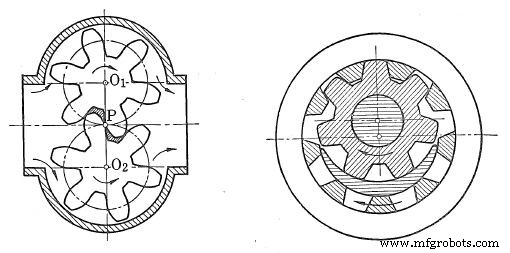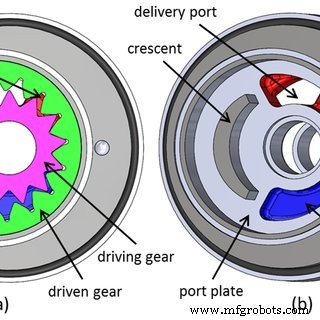Was bewirkt, dass eine Pumpe keinen Druck aufbaut?
Eine Pumpe ist eine Maschine, die dabei hilft, Flüssigkeiten von einem Ort zum anderen zu bewegen. Wenn bei einer Pumpe etwas schief geht, kann dies dazu führen, dass sich die Flüssigkeit nicht oder nur langsam bewegt. In diesem Artikel werden wir untersuchen, was dazu führt, dass eine Pumpe keinen Druck aufbaut, und wie Sie dies beheben können.
Was ist eine Pumpe?
Eine Pumpe ist eine Maschine, die ein flüssiges oder gasförmiges Fluid von einem Ort zum anderen befördert. Pumpen werden in vielen verschiedenen Branchen eingesetzt, einschließlich Wasseraufbereitungsanlagen und Chemieanlagen.
Pumpenausfälle können durch eine Vielzahl von Faktoren verursacht werden, darunter verstopfte Filter, verschlissene Lager und gebrochene Dichtungen. In vielen Fällen ist die Ursache für einen Pumpenausfall jedoch komplexer und erfordert weitere Untersuchungen.
Hier sind einige häufige Ursachen für einen Pumpenausfall:
-Filterverstopfung:Filter sind wichtige Komponenten der meisten Pumpen. Wenn sie verstopft sind, kann die Pumpe die Flüssigkeit nicht richtig fördern. Dies kann zu Schäden an der Pumpe und sogar zum Ausfall führen. Um dies zu verhindern, überprüfen Sie regelmäßig den Filterstatus und ersetzen Sie alle, die verstopft zu sein scheinen.
-Verschlissene Lager:Lager in der gesamten Maschine können mit der Zeit verschleißen. In diesem Fall verhindern die Lager, dass sich die Pumpe frei bewegen kann, und fallen schließlich aus. Um dies zu verhindern, überprüfen Sie sie regelmäßig und tauschen Sie abgenutzte Dichtungen aus.
-Gebrochene Dichtungen:Dichtungen sind wichtige Komponenten von Pumpen, die dazu beitragen, dass Wasser oder Gas reibungslos fließen. Wenn sie kaputt gehen,

Wie funktionieren Pumpen?
Eine Pumpe bewegt Flüssigkeit in und aus einem Tank oder Behälter. Der Druck im Inneren des Tanks oder Behälters bestimmt, wie schnell die Flüssigkeit ausfließen kann. Wenn der Druck zu niedrig ist, kann die Pumpe die Flüssigkeit nicht so schnell bewegen und ist weniger effektiv.
Was sind die Ursachen dafür, dass eine Pumpe keinen Druck aufbaut?
Es gibt ein paar Dinge, die dazu führen können, dass eine Pumpe keinen Druck aufbaut. Ein häufiges Problem ist niedriger Druck, der durch einen verstopften Pumpenfilter verursacht wird. Ein weiteres Problem sind niedrige Durchflussraten aufgrund unzureichender Pumpenleistung. Und schließlich kann eine Pumpe defekt sein.
Was sind die Ursachen dafür, dass eine Pumpe nicht genug Druck aufbaut?
Falsche Einstellungen an der Pumpe:
Die häufigste Ursache dafür, dass eine Pumpe nicht genug Druck aufbaut, sind falsche Einstellungen an der Pumpe. If the flow rate or suction pressure is not correct, the pump cannot create the necessary hydrostatic pressure to push water through the system.
The different factors that could be causing your pump to build less pressure.
There are a few different things that could be causing your pump to not build pressure:
-The air pressure in the tank is low. This can be caused by a leak, a defective gauge, or low air pressure outside. If the pressure is low enough, the pump will not work at all.
-The pump has not been installed correctly. Make sure the pump is properly connected to the tank and fittings, and that the hoses are properly routed.
-The pump’s motor is not working. Test the motor by plugging it into an outlet and turning it on. If it doesn’t work, replace it.
What should be done when the pump doesn’t build pressure?
Frequent causes of low pump pressure include:
– Dirty or clogged filters. Clean them regularly or replace them.
– Old or defective parts. Replace them as needed.
– Insufficiently sized tubing. Increase the size if necessary.
– Low engine oil pressure. Überprüfen Sie den Ölstand und füllen Sie bei Bedarf mehr nach.
Steps to take if your pump fails to build pressure
If your pump fails to build pressure, there are a few steps you can take to troubleshoot the issue.
1. Check the priming line – Make sure the priming line is not clogged or broken. If it is, debris can block the pump’s ability to prime properly.
2. Check the suction pipe – Make sure that the suction pipe isn’t blocked or clogged. If it is, debris can accumulate and block the pump’s ability to draw water.
3. Check the pump head – Make sure that the pump head isn’t bent or damaged. If it is, the pump may not be able to create enough pressure to circulate fluid through the system.
Other factors that could be causing low pressure in the tank
There could be a number of reasons why the pump might not be able to build pressure in the tank. One possibility is that there is something blocking the flow of water through the pump. This could be caused by debris, leaves, or ice buildup on the pump blades. Another possibility is that there is a problem with the plumbing connecting the pump to the tank. If there is a clog in the pipe, water will not be able to flow freely and pressure won’t be able to be built up in the tank.

Steps to take when trying to increase pressure
When trying to increase the pressure of a pump, it is important to take certain steps in order to prevent damage. Often times, these steps are as follows:
-Check the suction hose for obstruction or kinks. This can be caused by debris or materials caught in the hose, which will decrease the flow of air and water. If this is the case, remove any obstructions and try again.
-Make sure that the pump is properly installed. If it’s not level or if there are any other irregularities, this will also affect pressure.
-Ensure that all valves and fittings on the system are open and free from blockages. This includes both manual and automatic valves.
How can you troubleshoot a pump issue?
If you are experiencing a pump that is not building pressure, there are a few things that you can do to troubleshoot the issue. First, make sure that your pump is plugged into an outlet and that it is turned on. Also, make sure that your hoses are connected properly and that there is nothing blocking the flow of water into or out of the pump. Finally, check to see if there is any debris or sediment in your pump’s filter. If all of these steps fail to solve the issue, you may need to replace your pump.
Schlussfolgerung
As athletes, we are constantly striving to increase the pressure in our muscles. This is done by contracting our muscle fibers and pushing blood against the myocardium (the layer of heart muscle responsible for pumping blood). However, sometimes this process can falter and a pump may not be able to build pressure. There are many potential causes for this problem, but the most common one is fatigue. If you’re experiencing difficulty building pressure during your workout, make sure to take a break and assess whether you need more rest or if there is another issue at hand.
What causes a pump not to build pressure, please click topkitparts see more
Industrielle Ausrüstung
- Was verursacht Stringing im 3D-Druck?
- Was ist eine Jockeypumpe?
- Was ist eine Handpumpe?
- Was ist eine Druckpumpe für Haus?
- Was ist eine radiale Hydraulikpumpe?
- Was bewirkt, dass eine Hydraulikpumpe Druck verliert?
- Was ist BHP in Pumpen?
- Was würde dazu führen, dass eine Hydraulikpumpe Druck verliert?
- Was macht ein VFD an einer Pumpe?
- was die Kavitation der Hydraulikpumpe verursacht



